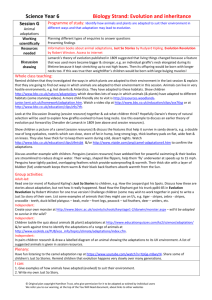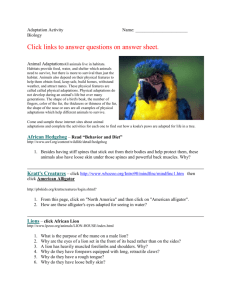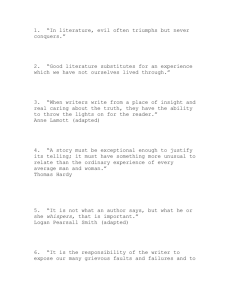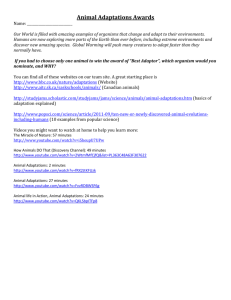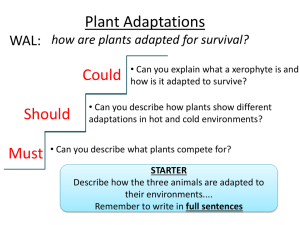Ch. 7: Adaptations
advertisement
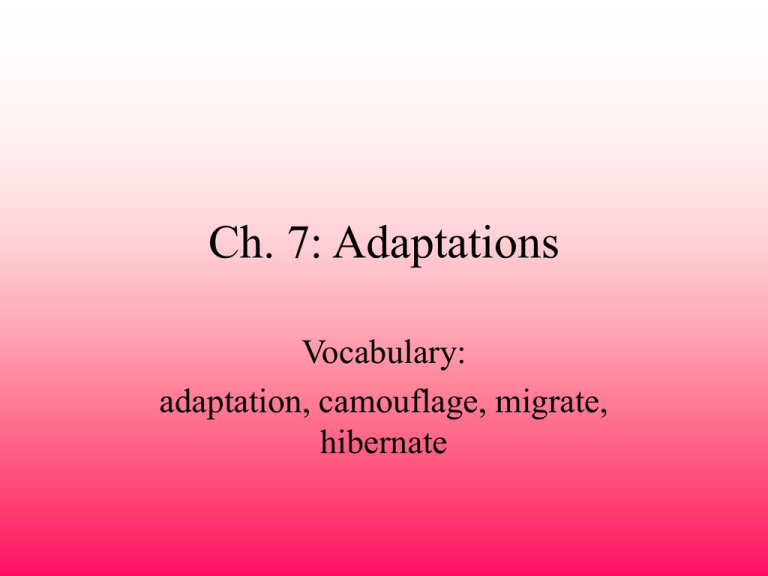
Ch. 7: Adaptations Vocabulary: adaptation, camouflage, migrate, hibernate Body Parts That Are Adaptations • Adaptations are features on a plant or animal that helps them to survive. • Adaptations can be body parts. • Poison Dart Frogs are brightly colored to warn predators that they are poisonous. • Wolves have strong chest muscles that let them run for hours to chase down prey. • Zebra have stripes that let them hide among other zebras. • Squirrels have bushy tails that allow them to balance in trees. Bodies Adapting to Ecosystems • Living in different places causes animals to adapt in different ways. • Tropical Rainforest animals are usually small and able to live in trees. • They are also well adapted to living in an area that gets lots of rain. • Because of the amount of rain, tropical rainforest plants are usually tall and green for most to all of the year. Bodies Adapting to Ecosystems • Most animals that live in subtropical savannas have adapted camouflage, because there are few trees to hide in. • Camouflage allows the animals to blend in with their environments. • Plants on the savanna are short and thin, they have adapted to live on very little water, since it rains so infrequently. Bodies Adapting to Ecosystems • Animals and plants in the desert ecosystem have adapted to need less water than even the savanna plants and animals. • Most plants in the deserts have adapted ways to store water during the long months without rain. • Some animals have adapted big ears to release body heat into the atmosphere so they do not become overheated. Bodies Adapting to Ecosystems • Plants have adapted to the underwater ecosystem by loosing the structures in their cells that make them rigid, so that they will not break in a current. • Kelp, a type of seaweed, has adapted to life underwater by developing a root system called a hold fast that grips rocks like fingers to keep it from floating away. • Underwater animals have adapted gills, so that they can remove oxygen from water; and flippers or fins so that they can swim more easily. Bodies Adapting to Ecosystems • Because of the amount of wind, plants in the temperate grasslands have adapted to be short and flexible. • Animals have adapted to either feed on the grasses that grow there or to feed on the animals that eat the grasses. • For the colder weather in the winter in temperate areas, animals have adapted shaggy fur coats that they can shed when temperatures get warmer. Bodies Adapting to Ecosystems • Temperate and coniferous forest adaptations are similar to temperate grassland adaptations. • The exception, is that because of the lack of wind: plants have adapted to grow taller and animals have adapted to live in and around the trees. Bodies Adapting to Ecosystems • Animals and plants that live in the polar regions of our planet have developed many adaptations to stay alive. • Plants are very small and grow quickly during brief summer in polar areas. • Animals have adapted thick coats that never shed and thick layers of fat, or blubber, to keep them warm. Adaptations That Are Behaviors • Not all adaptations are the ways that animals and plants bodies are shaped. • Sometimes animals can the way they act in the areas they live. • These are called behavioral adaptations Behavioral Adaptations • Most behavioral adaptations occur because of winter. • For example, when temperatures get cold enough, birds and other animals migrate from place to place. • Other animals hibernate during the winter, so they will not use as much energy when the is very little food. Migrating Birds Hibernating Dormouse Questions about Chapter 7 1. What are two animal adaptations for life in area where it gets cold? 2. Cheetahs have black spots on their yellow coats. This pattern helps them blend into tall grass. Name the adaptation that this is an example of. 3. Name two adaptations that plants have made to live in underwater environments. 4. Describe what an adaption is. 5. Why have birds adapted different shaped beaks?
